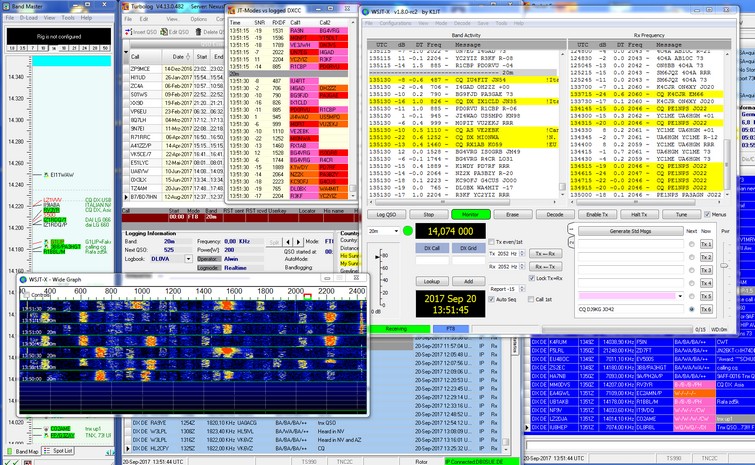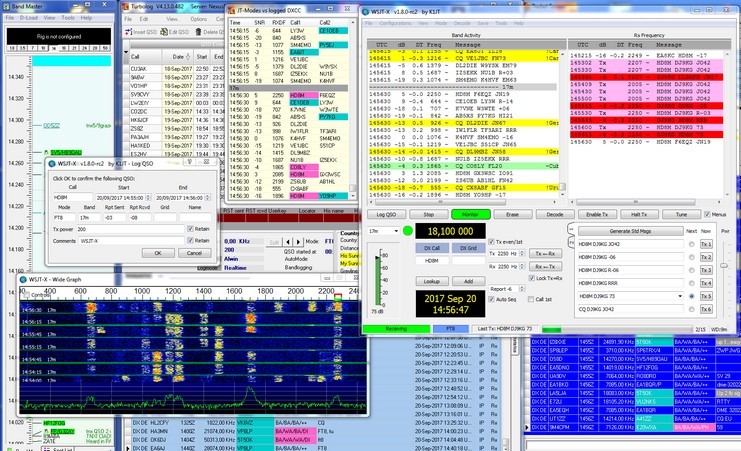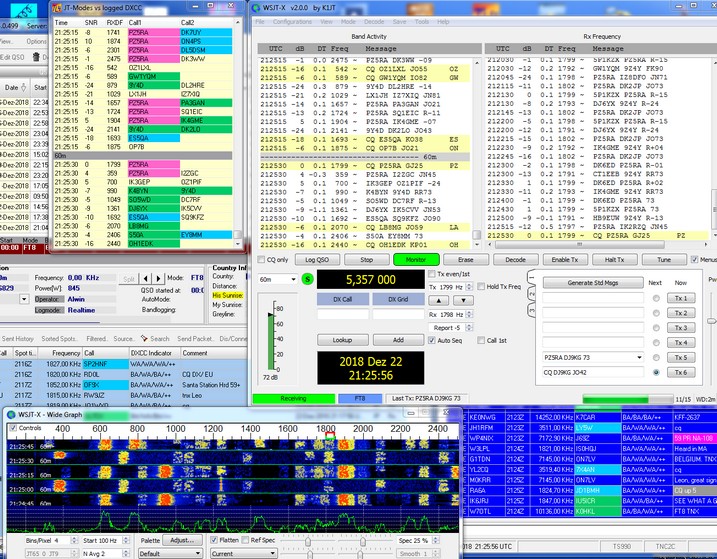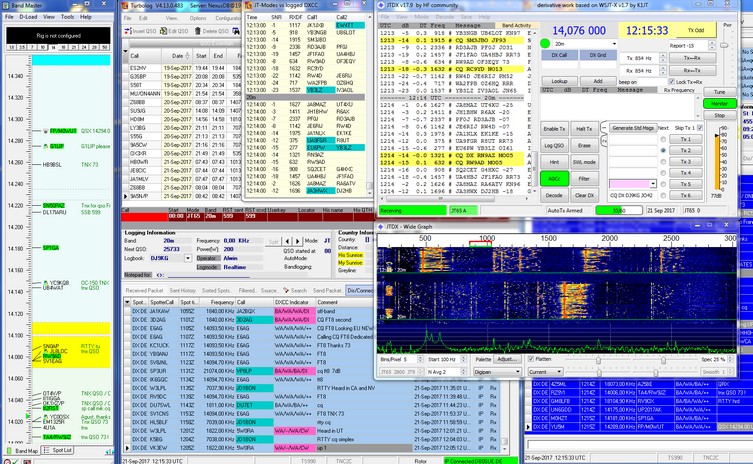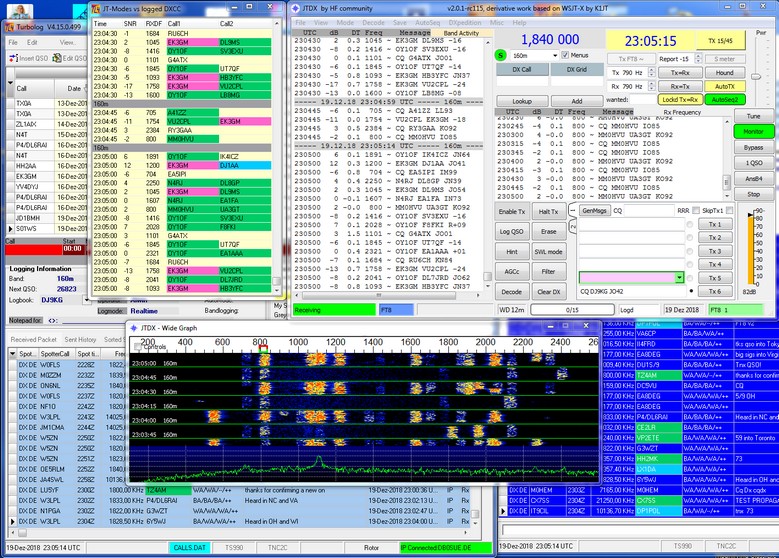General:
Famous Nobel laureate Joseph Taylor/K1JT has invented a group of digital transmission modes which have now become very popular. These modes are based on narrow band multiple tone frequency shift keying (FSK). He and his development team have adapted these modes ( dubbed JT-Modes ) to various HF and UHF propagation conditions such as Weak Signal HF propagation, moon bouncing (EME) and Meteor Scatter ( MS ) operation, just to mention the main applications. Implementation of easy to use programs was feasible by applying sophisticated software and coding techniques and extensively using the sound card of modern PC systems.
Basically, the different transmission modes which were developed are using a restricted set of characters and message length while signal parameters such as:
•Bandwidth
•Number of tones, their spacing and duration
•Baud rate of transmission
•Added redundancy and FEC (Forward Error Correction)
•Total length of emission
are varied and careful selections may yield detection thresholds as low as -30dB SNR (Signal-to-Noise-Ratio). Thus, even CW is outperformed by about 15dB. This explains the popularity of modes like JT65A. However, the price for performance at this level is an extended emission time. Thus, one over may last one minute and a complete QSO may take several minutes.
A real breakthrough was reached this year (2017) with the release of the new FT8 mode (Franke-Taylor-8-tone). FT8 is 4 times faster than JT65A while currently (... in Version 2.0 ) exhibiting a detection threshold of about -24dB SNR.
Most importantly: FT8 now includes a special DX-pedition mode (Fox / Hound) with great benefits for an even (...up to 5 times ) faster DX traffic.
In the meantime a new mode FT4 was released (May-2019). This mode is designed for digital contest operations similar to RTTY but outperforms this mode by speed, bandwidth and detection threshold.
As can be observed on the HF bands and on 6m this performance resulted in a huge boost of popularity. However and unfortunately, this mode of operation turned out to be not fool proof. Recently, the Calls of DXpeditions running F/H traffic were massively abused. In order to cope with spoofing a new F/H-mode dubbed SUPERFOX was introduced and made available to the public in Release Candidate WSJT-X 2.7.0-rc7.
This lead to our conclusion to interface TurboLog 4 to the whole range of JT-Modes and to exploit its benefits for our users.
More technical details can be found in the bulk of literature which exists in the meantime and in the User Guide at:
https://wsjt.sourceforge.io/wsjtx-doc/wsjtx-main-2.7.0-rc7.html#SUPPORT
K1JT's software packages are open source programs distributed under terms of the GNU General Public License. Several teams of software volunteers world wide have forked out clones from K1JT's original source code. Partially improvements of some significance have been achieved. The interface we describe below has been successfully tested and operated on WSJT-X and JTDX and MSHV.. We may integrate other clones at a later date.
WSJT-X can be downloaded from: https://wsjt.sourceforge.io/wsjtx.html as wsjtx-2.1.0-rc7-win32.exe or wsjtx-2.1.0-rc7-win64.exe. ( 12/12/2024 )
The release notes are found at: https://wsjt.sourceforge.io/wsjtx-doc/Release_Notes_2.7.0-rc7.txt
The User Guide for the SUPERFOX mode can be downloaded at: https://wsjt.sourceforge.io/SuperFox_User_Guide.pdf
Unfortunately, the active development of JTDX has ceased. with version JTDX-2.0.1-rc137-win32.exe .
However, In case of problems with JTDX you can contact the JTDX Yahoo Technical Group.
Implementation:
Interfacing to K1JT's genuine software package WSJT-X has become feasible thanks to data telegrams which are provided on an UDP communication port (UDP = User Datagram Protocol). For the time being this is a one-way communication off WSJT-X only. There is no return channel back into WSJT-X. The UPD telegrams can be intercepted and decoded by a suitably designed application running on the same PC platform. We have implemented a new intercept and processing software package in TurboLog 4 which allows us to perform the following highly useful tasks:
1.Direct logging (=default) into TurboLog 4's logbook. This includes contest operations in WSJT-X V2.x. There is no more need for manual importing logbook data via an ADIF round trip.
2.Automatic checking of all decoded calls which are displayed in the Band Activity box in WSJT-X against the DXCC database in TurboLog 4. During busy hours on the bands there may be 30 to 40 decoded messages coming in every 15s. It is virtually impossible to visually analyze 60 to 80 calls in that time frame with respect to relevance for the user's DXCC standings. Thus, we have developed an Adjunct Band Activity box in TurboLog 4 which processes every call and highlights the significant ones. The user only needs to care for (... and preferably work ) the calls marked on red... . This is an enormous operational benefit!
3.Gaining more information on a particular call of interest such as name or QTH from QRZ.COM or on the operator's QSLing attitudes.
4.Highlighting of LoTW User Activity, if enabled in Log Setup.
The interface to the programs has to be set up and can be customized in Log Setup as a sub item under the Devices menu.
Before WSJT-X is downloaded and installed the user's station should be set up properly for in- and output of audio signals to the sound card of the PC. WSJT-X also needs PTT and CAT control of the TRX. While the PTT port can be shared the CAT control has to be shifted from TurboLog 4 to WSJT-X. This can easily be achieved by applying the hotkey Ctrl+Shift+T since this command toggles the CAT to ON/OFF. We are reluctant to recommend Virtual COM-port Splitters for this application and for the time being because of unforeseeable side effects.
In order to start the operation TurboLog 4 and WSJT-X have to be started independently of each other.
Currently ( 12/12/2024 ) there are just two small nuisances at start-up of WSJT-X V2.0:
1. WSJT-X wants to connect to the ARRL's website and load the file "LoTW User Activity". This would require to install a large repository of DLL files in your Windows system folder. We recommend to refrain from using this feature at all since we will provide a more comprehensive implementation of highlighting by LoTW User Activity in our upcoming version of TL4.15. Thus, just acknowledge the error message and continue.
2. WSJT-X now comes with a large (...and confusing ) bunch of color highlighting which is all based on its private set of records collected in its ADIF logbook file. Thus, this file must be imported. The import fails because the inherited ADIF file's header is not structured as expected. Obviously this can be overcome by simply editing the ADIF file which is named wsjtx_log.adi and including a first line to read: WSJT-X ADIF Export<eoh>. Likewise you could just rename the file (or delete it) which will cause the program to create a new, 'correct' one as soon as you log a new QSO. The full path to the file typically is (in WIN-7 ):
C:\Users\Turbolog\AppData\Local\WSJT-X
Anyway, we recommend to refrain from the most of WSJT-X's private highlighting features except for a few, e.g. CQ calls, etc. Reason is: The DX related highlighting is solely based on FT8 QSOs in WSJT-X. Since TurboLog 4 provides the full picture based on all Modes you operated (NB: there are still other Modes than just the JT-Modes...) you could also just again acknowledge the error message and continue.
WSJT-X has to be set up according to its user instructions which can be downloaded or started from its HELP menu. It just takes a short time to become acquainted with the main features. WSJT-X remembers its last mode and immediately starts its operation when all necessary inputs are entered in the Settings sub menu. The WSJT-X shell currently ( 12/12/2024) comprises of the following digital modes:
•FT8 incl. Fox/Hound and SUPERFOX DX-pedition mode
•FT4
•JT4
•JT9
•JT65
•QRA64
•ISCAT
•MSK144
•( WSPR, FST4W and Echo)
•FST4.
As soon as decoded messages appear in WSJT-X's Band Activity box the Adjunct Band Activity and analysis frame is opened by TurboLog 4. For ease of operation both frames should be positioned side by side. The resulting screen which can fully be customized by the user then may look like in the following screen shot:
As can be seen the WSJT-X main frame and the spectral Wide Graph have been placed on TurboLog 4's windows. Please note the Adjunct Band Activity box ( dubbed: JT-Modes versus logged DXCC ) being positioned side by side to the Band Activity box of WSJT-X. This positioning allows to allocate corresponding decoded messages on the first glance. This is assisted by the gray lines which separate RX-periods from each other. For demonstration purposes an almost empty logbook was selected for checking decoded calls against its DXCC standings. Thus, as the highlighting background colors show all calls are relevant for user interaction. The color scheme is identical to Packet Spot Highlighting. All color assignments can be customized by the user in the Setup. The following categories of DXCC standings can be assigned for display in the Adjunct Band Activity box:
•All time new DXCC entity ( "New country" ) . This is the highest priority
•New for any mode on this band ( "New Band" )
•New Mode for this band ( "New Mode" )
•Call was worked before, some Mode - some Band. We check for Base Calls. Thus, it may also have been worked in a compound call.
•LoTW User Activity, if enabled in the Log Setup menu. This is the lowest priority
While the search by the highlighting routine is running the search items are prioritized as indicated. Only the highest priority item found will be highlighted according to the selected background color.
It may require a little bit of fiddling around in order to properly adjust the windows because they belong to different programs. However, this is WINDOWS!
A double click on any call in the Adjunct Band Activity box will transfer it into the Call field of TurboLog 4's log entry line. This not only allows to inspect the DXCC standings for the entity it belongs to but also to access the QRZ.COM database and internal databases for gaining all collected information for the particular station.
Upon finishing a QSO the user is prompted by WSJT-X to eventually add additional remarks and to enter the QSO by pressing the OK button as shown on the screen shot below. This yields a log entry in WSJT-X and an ADIF record for export. However, TurboLog 4 now captures the log record as well and puts it directly ( by default ) into its log book data base, including contest exchanges. If the user wanted to include more information into the sparsely filled record ( e.g. Name, QTH, etc. ) he could select the Setup option to intermediately place the record on the log entry line in order to complete it and finally to enter it manually.
The next screen shot depicts FT8 operation of WSJT-x V2.00 interfaced by TurboLog 4's JT-Box. The box also shows highlighting as enabled by the user for DXCC and LoTW User Activity:
Please note:
The Adjunct Band Activity box must have the 'always-stay-on-top' property. Otherwise it would be virtually impossible to properly arrange the open windows, e.g. in the way as shown in the screen shots above. However, the arrangement of all windows can be customized by the user.
Please further note:
While WSJT-X did not provide UDP telegrams in the FOX/HOUND DXpedition mode (versions 1.9.xx ) it now does in V2.0x. In this aspect the development team of WSJT-X followed a suggestion which we made several times.
JTDX is a clone that has an active user community and a very busy development crew. Furthermore, apparently the signal detection algorithm for JT65 was successfully improved over WSJT-X. Additionally the new digital mode T10 was invented and added to the set of digital modes. JTDX now also provides FT8 including the Fox/Hound DX-pedition mode. For the time being ( 12/12/2024 ) FT4 is not available. The following digital modes are currently available in JTDX:
•JT9
•T10
•JT65
•JT9+JT65
•WSPR-2
•FT8
The screen shot below shows the interaction between JTDX and TurboLog 4:
Thanks to a common set of UDP telegrams the interaction between JTDX and TurboLog 4 is practically the same. As can be seen from the example shown above the Adjunct Band Activity box is now fed from the JTDX shell. All operational properties as described above for WSJT-X are identical. This applies for the logging procedure explicitly too.
Thus, the user can switch within just a few seconds between both utilities. This allows to benefit from the particular modes which they provide and their different operational characteristics.
The final screen shot demonstrates FT8 operation by JTDX V2.01 RC 115 interfaced to TurboLog 4. Its adjunct JT-box shows DXCC related and LoTW User Activity highlighting being activated by the user:
Before you can run the JT-Modes you will carefully need to set up the SETTINGS items in the applications. This paragraph will lead you through this task by means of a typical layout, or example DJ9KG's.
The starting point is shown in the following screen shot:
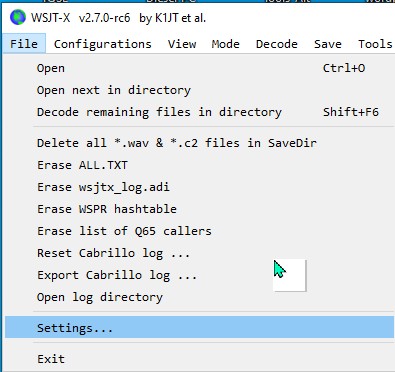
Figure 307: WSJT-X Settings Cotrol on the Main Menu
Clicking the Settings item on the menu will yield the General sub menu. You will need to enter your identification and your personal preferences on this tab:
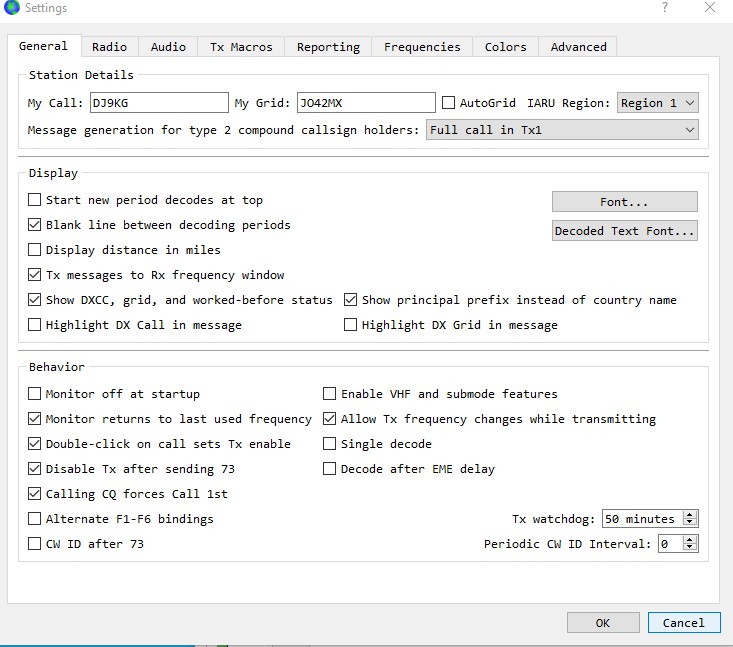
Figure 308: WSJT-X Settings: General Tab
Please continue with the RADIO tab. Entries on this tab require some technical expertise. However, if you already had established a correct CAT link to your TRX you just need to transfer the relevant parameters into this tab, such as rig name, COM-port, Baud rate, Data bits and handshake conventions. The PTT details require special attention. If you have used other digital modes in TurboLog 4 you already should have defined a separate COM-port for this purpose. Thus, you just enter the control line accordingly. Don't worry about the troublesome external Hamlib package. Fortunately, TurboLog 4 uses its own proprietary CAT system.
Please note:
Real COM-ports allow just one unique user in your PC-environment at a time.Thus, simply use the toggle hot key Ctrl+Shift+T to switch between normal CAT- and JT-Mode operation.
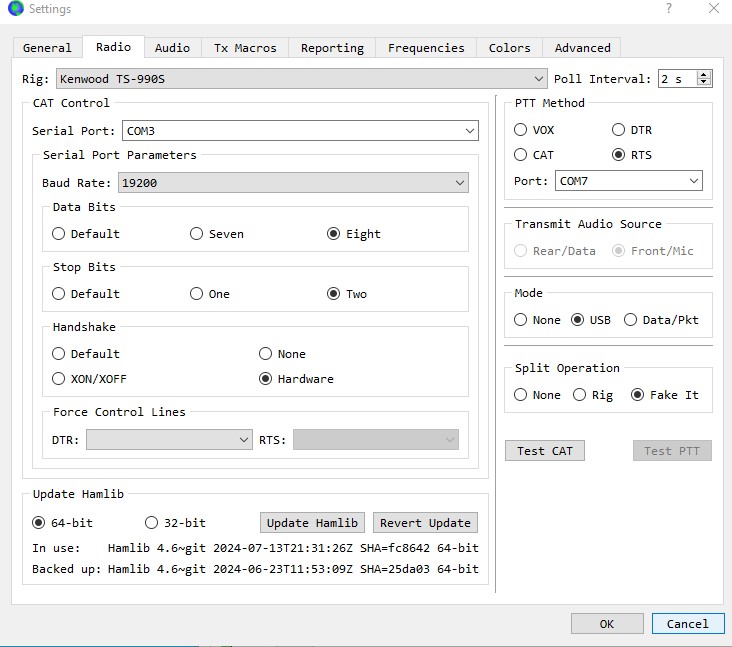
Figure 309: WSJT-X Settings: RADIO Tab
The AUDIO tab sheet is next. Parameters depending on the type of your sound card will have to be entered here:
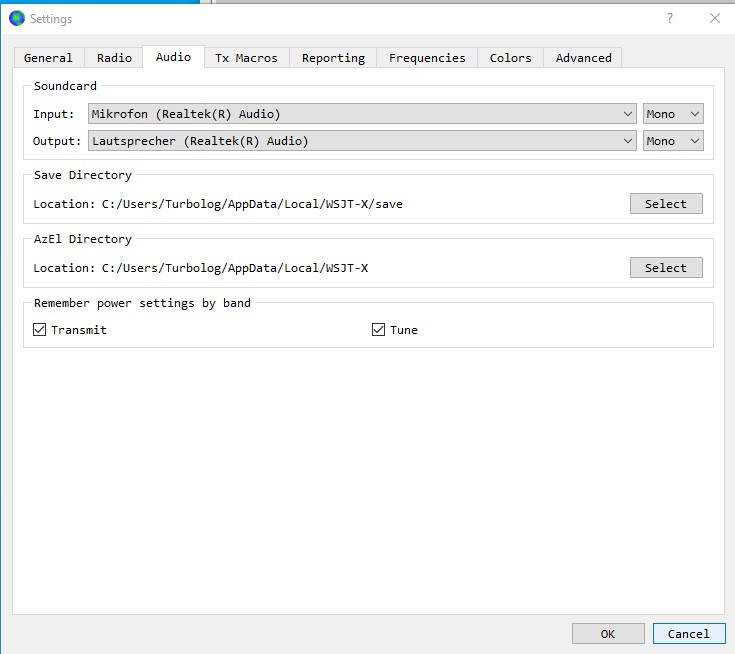
Figure 310: WSJT-X Settings: AUDIO Tab
The TX MACROS tab follows. It allows you to predefine macros you may want or need to use:
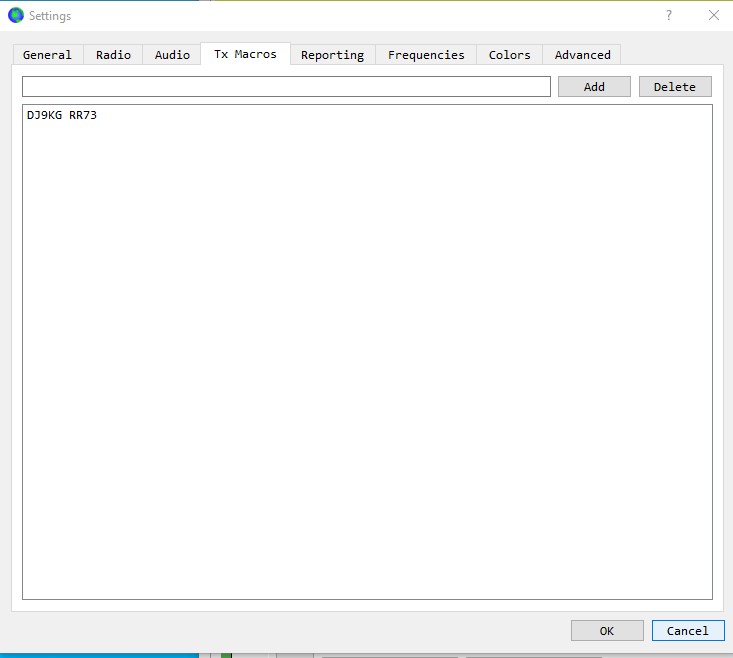
Figure 311: WSJT-X Setting TX MACROS Tab
The REPORTING tab allows you to specify ex-/internal communication links ... among other controls as shown below:
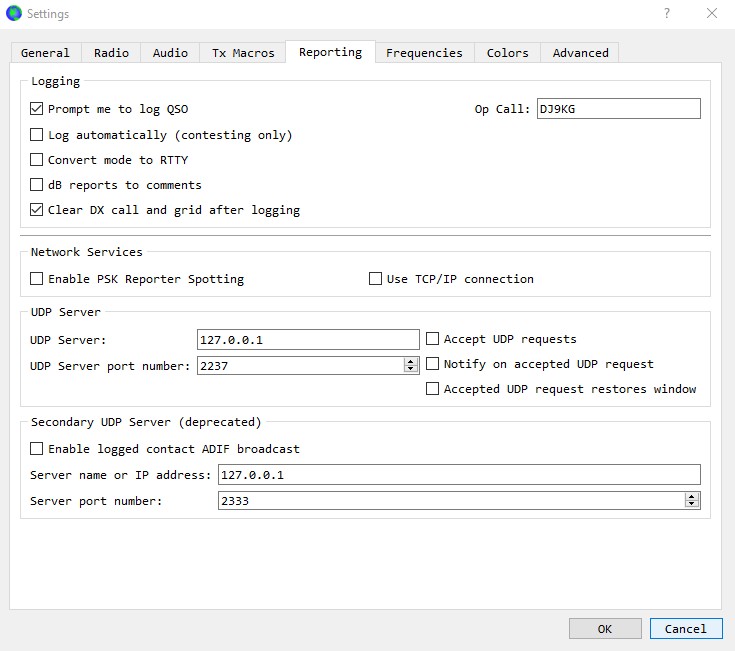
Figure 312: WSJT-X Setting REPORTING Tab
The FREQUENCIES tab lets you enter Band activity centers for the different JT-Modes:
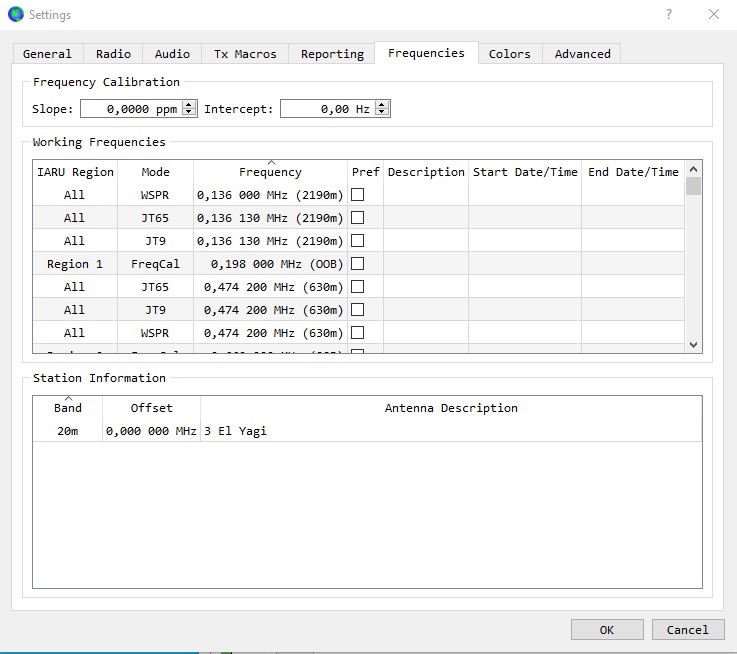
Figure 313: WSJT-X Setting FREQUENCIES Tab
The COLORS tab lets you assign colors for various highlighting purposes:
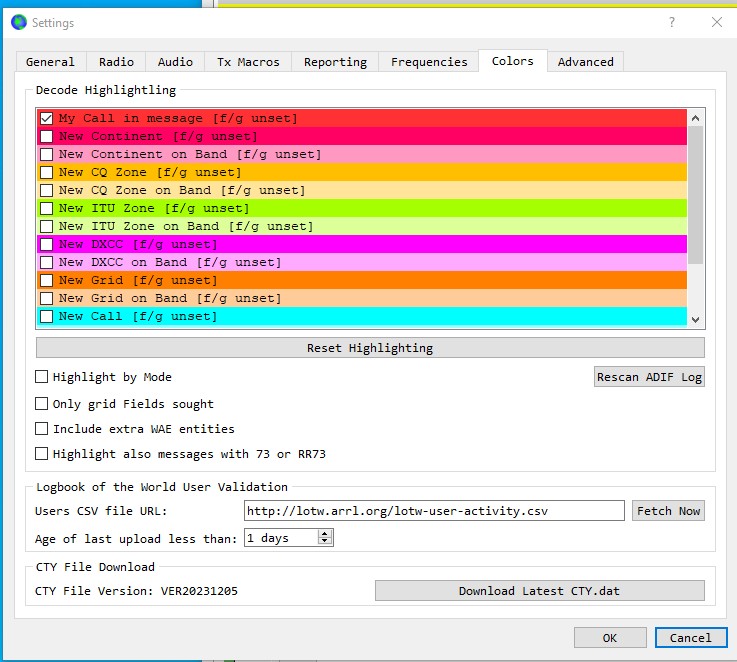
Figure 314: WSJT-X Setting COLORS Tab
The ADVANCED tab is important to visit in view of operational modes, e.g. FOX, HOUND, SUPERFOX. Furthermore, you can select a number of popular digital contest modes, if you are interested to participate in one of those:
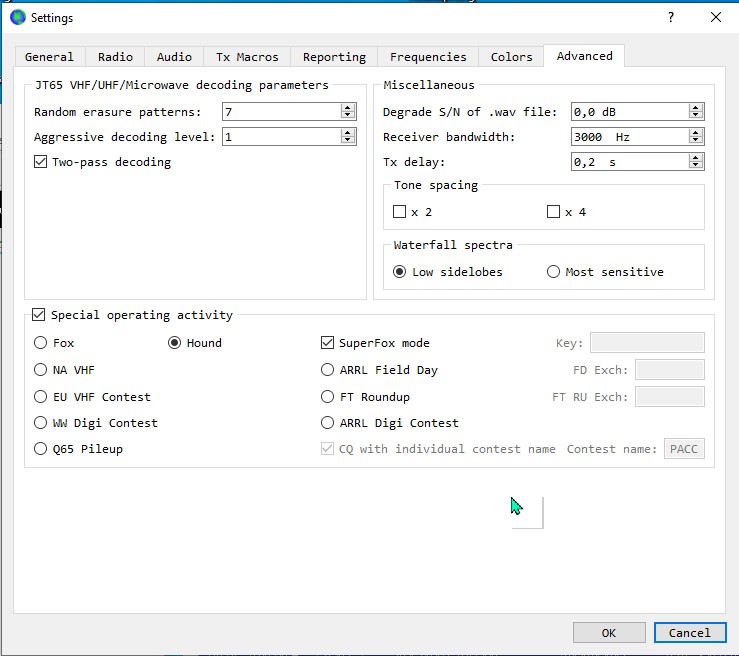
Figure 315: WSJT-X Setting ADVANCED Tab
Clickables in the Adjunct JT-Box:
Double Click on Header line resets column widths to default values (see Text number 1450 in Turbolog.asc ).
Mouse dragging column widths can be customized permanently by dragging the vertical separator lines in the box's header
| Double Click | on any Call in the columns transfers it into theCall field of the Log Input Line for close inspections (DXCC, QRZ.COM, etc. ). |
Clickables in the tabs of the SETTINGS Menu of the JT-Apps:
OK Confirm entries and leave the tab.
CANCEL Discard changes and leave
This topic was last edited on Thursday, 12-Dec-2024, at 13:30
